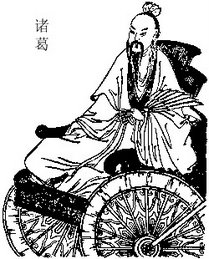The next morning we were informed that the local officals couldn't find a car from their office, as all cars were sent out on assignments. What should we do then? The locals pointed and said, "You take that car to the next town, where they will have further arrangement."
I looked it up, and it was a car which exterior looked too familiar. We got in the car together, and I whispered to Deng, "Is this really a police car?" He nodded, as if he was not surprised.
My excitement didn't last very long, because quickly a few more people crawled in. When the door finally closed, there were three people in the front and four people in the back. One of the guys in the back - sitting next to me - even tried to light up a cigarette until Deng stopped him. The whole situation in the car was probably illegal by any country's traffic law, but for the moment, "we are the police."
The car ran very fast, to no one's surprise, and a couple of times they used siren to clear up the traffic in front. Not that there were many vehicles on the road, but the road was simply too narrow, and our driver was feeling very competitive that morning.
One by one people inside the car reached their destination. Before I could enjoy the breathing room, we arrived at the next town. We jumped on our next vehicle - a small van - and continued our journey.
Soon we saw the Great Wall. It was not at all what I had imagined.
To see the Great Wall had been one of my longest awaited dream. By then I had been in Beijing a couple of times, but each time the stay was too short to do any sightseeing, including to see the Great Wall nearby. Finally, here, near the ancient battlefields in the Northwest, I saw the Great Wall.
I couldn't believe my eyes. It was nothing like what I had seen in the post cards, where tall brick walls and broad pavement on the top symbolized a once magnificant empire. That was the sections near Beijing, which were restored in the Ming Dynasty (around 500 years ago). Here, we saw a section of the Great Wall that was built much earlier, more than 2,000 years ago in the Qin Dynasty. It was only about two-men tall. I couldn't see how wide it was from our van, but later I had a chance to walk on the top of it, and it was barely wide enough for two people walking side by side - unlike the sections near Beijing, where it was said that five horses could run side by side at the top.
The word for the Great Wall in Chinese is Chang Cheng, which literally means "long castle." Whoever translated it to "Great Wall" must have seen the sections elsewhere first, for here, the wall was nothing "great," but it was indeed very, very long. I couldn't see the end of it. Despite its unimpressive height, its sheer length did create an awesome feeling.
I soon learned two very interesting facts about this section of the Great Wall. One was that it was made of earth, not typical building bricks or stones. Or more precisely, tamped earth without any further treatment. How could such a wall stand 2,000 years? To answer that, one had to know the earth of the Northwest. It was the Yellow Earth. A main characteristic of the yellow earth was that when water washed through it, the yellow earth didn't absorb much of the water or got "resolved" by the water. Instead it let the water permeate; and that only made the earth more sticky and holding itself stronger. The more the water washed, the stronger the earth became, so to speak. That was the same yellow earth that the people in the Northwest had used to build their houses for many years.
The second thing I noticed was that the road we were driving on appeared to be in perfect parellel as the Great Wall. (Due to my work, I paid much attention to the roads because the optical fibers were buried along and off the roads - so that if any section of the optical fibers got damaged, the repairman could arrived at the scene quickly by the road, although ironically, often the optical fibers got cut because of road constructions.) The driver explained that when they first built the road, they studied the geography of this area, including the mountain shapes and river trends. The road builder finally concluded that the current route was the best route to take advantage of the natural barriers. The "perfect parallel" between the route and the ancient Great Wall could mean only one thing:
Somebody discovered the same thing 2,000 years ago.
